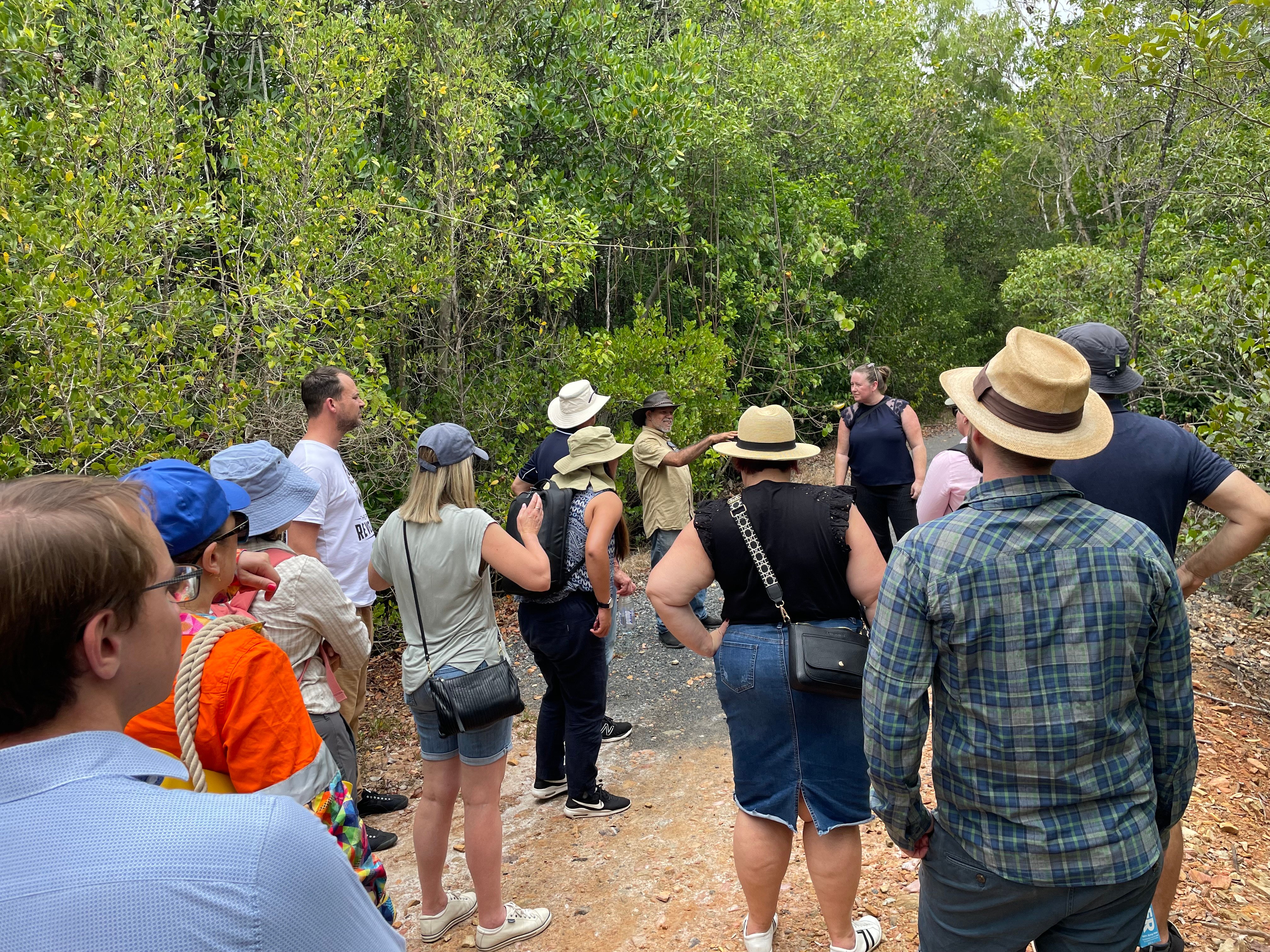Cultural Water Flows – Learnings from a Walkabout Journey in Cairns

In October 2022, delegates of the AWA Queensland Conference had the opportunity to attend a guided tour of Cairns City’s spiritual and life connection with water, with Gimuy Walibara Yidinji Elder, Gudju Gudju, a local tribal ecologist and sacred knowledge holder, and his wife, Jenny Lynch, a Western-trained ecologist from Ireland. Gudju Gudju and Jenny formed their company, Abriculture, in 2000 after meeting at a Rainforest Conservation conference at James Cook University. They are passionate about reviving and promoting the ancient connections between people, land and ecosystems based on the philosophy that when the land is strong and healthy, its people are dynamic and resilient.
Our journey with Gudju Gudju and Jenny took us on a 2-hour long walking tour of the lush and tropical Flecker Botanical Gardens. Here, we learned about the history of land transformation since the early settlers first arrived, and the importance of land and water management practices.
Gudju Gudju shared stories of the creation of his traditional lands around Cairns (or “Gimuy” as it was known then) and the connection to water. In sharing these ancient stories, Gudju Gudju and Jenny emphasised the importance of cultural flows through storytelling, dance and art, and the deep Aboriginal cultural and life connection to water, which flows from the top of the mountain, down to the streams, the wetlands, rainforests, coastlines and eventually the Great Barrier Reef. They remind us of the importance to always keep cultural and environmental flows strongly connected and moving. This philosophy can be applied to every project we work on in Australia, whether it be natural resources management or water infrastructure design. We need to start by taking the time to listen and understand the ancient Aboriginal and Torres Islander stories of the land we are working on. From there, we need to work together with local Indigenous people to help them protect their cultural heritage, knowledge and the health of their water and water places. We also need to harness their local water knowledge and challenge conventional western engineering practices for better, more sustainable outcomes.
Joining us on our walk from Cairns Regional Council were Toni Veronese (Manager of Utility Services) and Lynne Powell (Strategic Policy and Compliance Coordinator) who explained that council is carrying out studies in partnership with James Cook University to explore the possibilities of enhancing and restoring the Saltwater Creek catchment, an urban waterway that flows right through the botanic gardens. A holistic management approach is also underway to mitigate the impacts of flooding, future climate change and saltwater intrusion, to improve the water quality discharged to the Great Barrier Reef, restore natural ecosystems and benefit residents by improving livability. Abriculture is providing specialist Indigenous stakeholder consultation support on this important project.
As we walked through the Rainforest Boardwalk part of the gardens, we were able to imagine what the coastal areas of Cairns once looked like before settlement. Gudju Gudju and Jenny pointed out that the rainforest provided everything for the Aboriginal people who lived in there: spirituality, shelter, food water and medicine. The rainforest was akin to a natural irrigation system, drawing up groundwater, releasing it back into the atmosphere in the form of swirling mists and clouds, and distributing water back down to the people and animals via the tall paperbark trees, palm trees and vines, to the waterways, where it could be collected for drinking. It was also like a supermarket, with GudjuGudju pointing out many edible fruits and vegetables along the way, including the native mangrove apples, pandanus fruits, quandongs, plums, cherries, figs, lemon myrtle and yams. We tasted the Lomandra longifolia grass bush, which ancestors used to chew and suck on the pale green shoots to alleviate hunger and use the leaves for weaving baskets and fish traps. It tasted like celery or raw cabbage. Gudju Gudju was quick to alert us about the stinging tree to be avoided, and then showed us some of the plants that can be used to take away the sting, and other bush medicines, such as saps that can be used to heal cuts. We passed crocodile-infested mangroves, and we learned about the sand ridges and waterways that once flowed more abundantly, which filtered the water and provided much better cyclone and flood mitigation compared with today, following early settler infill of the sand ridges.
We learned so much during our 2-hour walkabout. Every couple of steps, Gudju Gudju and Jenny would observe something new, triggered by a plant or an animal we walked past. Their ability to read nature, recollect ancient stories and transpose them into parallel examples of the importance of sustainability taught us what Connection to Country is all about. The living knowledge they can share will hopefully be listened to and incorporated into future solutions that are currently being planned to help the community enjoy healthier waterways, with improved protection against cyclones and floods.
